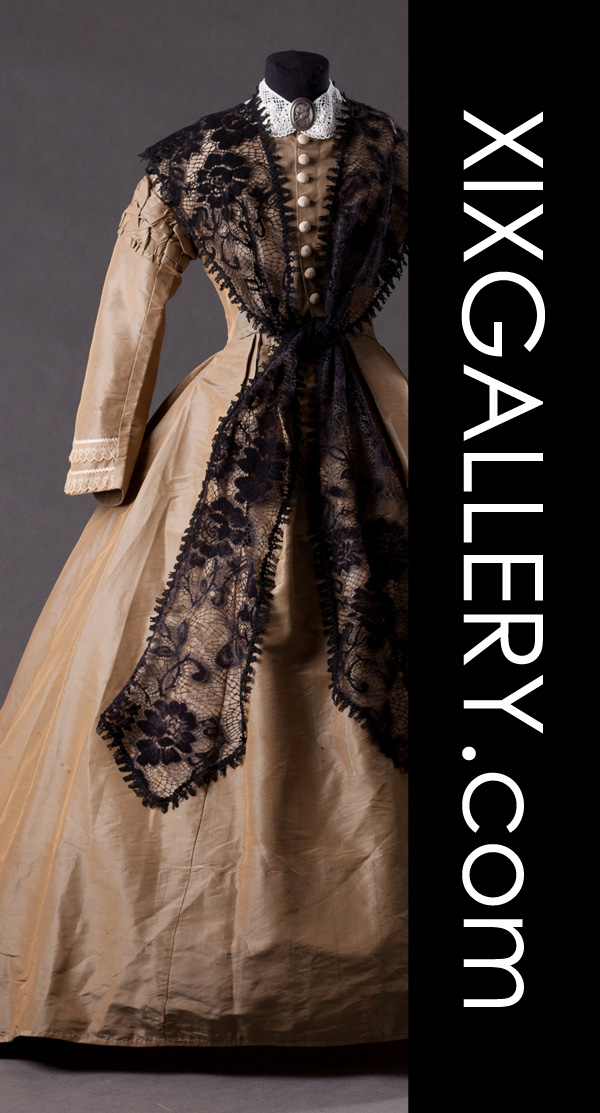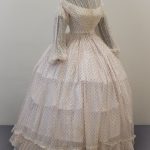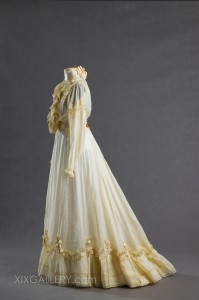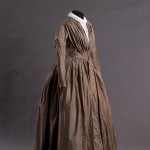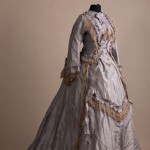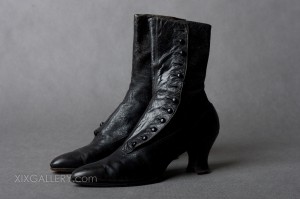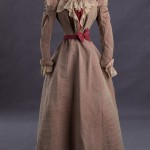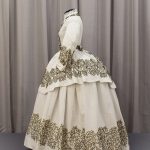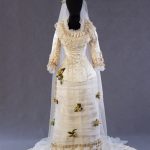Collection
A collection of antique clothing and fashion accessories originating mainly from the 19th century, created by Anna Moryto. The collection includes the largest privately-owned collection of 19th-century, complete dresses in Poland. They are regularly available to the public. There are over 50 antique exhibits in the constantly growing collection.
The collection aims to popularize knowledge about the fashion history of the 19th century, it also enables you to view “live” unique exhibits. In addition, the collection is a support, as well as a source of practical knowledge and expertise of the restorer of historical costumes.
The most interesting exhibits include:
- Summer dress from the 1840s
- Dress from 1840 with decoration made of fake buttons
- Evening gown, ca. 1880, from B. Altman department store
Selected exhibits:
Antique costumes:
Black silk mourning dress, circa 1875-1880
Black silk dress, circa 1875-1880
This dress has a separate bodice and skirt. It is made of black silk satin. Decorations in the form of flowers are made of floss and chenille. The bodice has a small pocket for a medallion.
The costume from that...
Bodice, circa 1845-1855
Bodice is made of black silk. It has a wide basquine trimmed with silk fringes.
Sleeves are rather tight and long. This kind of bodice was worn with skirts supported by dome-shape crinoline.
Original vintage bodice.
Day dress of the 1860s
The dress is made of transparent cotton fabric. The fabric is white with small red circles. The skirt is decorated with a furbelow and lace at the edge. The neck is trimmed with a silk ribbon. This dress is a costume designed to be worn on summer and...
Dress - the turn of the 19th and 20th centuries
The dress was made of a light cream cotton fabric. It is decorated with many flounces and silk ribbons. The dress has a small train and distinctive shape of an inverted lily flower. Bodice is not close-fitted and hangs over the waist. Dresses of that...
Dress of the 1840s
Dress is made of beige silk. The bodice is fan pleated. Skirt is simple and cartridge pleated, it was a very popular cut in the 1840s and 1850s. The only decoration of the skirt is a front panel with false buttons. Short sleeves are trimmed with light ...
Dress, circa 1864
Dress is made of shot silk. It is not richly decorated. The sleeves are trimmed with a strip of fabric. The inside of the bodice is stabilized with natural whalebone. Costumes from that period were worn with big, conical crinolines with elongated back. ...
Dress, circa 1868 - 1870
The dress is made of gray, shiny silk. It is richly decorated with silk fringes and frills. The bodice fringes and buttons are golden-orange in color. The combination of these two colors made the dress interesting and very adorned. This specific color...
Dress, circa 1875-1884
The dress is made of a navy blue, most probably woolen fabric. This is a one-piece princesse-type dress. Decorations were made of the same fabric as the dress itself, using popular motifs such as pleated tapes and "connecting elements" at the front skirt....
Dress, circa 1887-1889
The dress is made of a cream-colored woolen fabric. Its interior is stabilized with whalebone. The edge of the bodice, as well as the tail are trimmed with lace. The balloon sleeves are not stiffened and loosely fall along the shoulders. The neckline...
Dress, circa 1893-1897.
The dress is made of green wool. There is a velvet belt at the front. It is decorated with an appliqué made of black string, as well as black haberdashery. The dress has ample sleeves, which became popular again in the late 19th century. The interior o...
Evening dress, circa 1880
The dress is made of striped silk fabric in golden-cream color. The bodice has slit sleeves, finished with a ribbon at the elbow and lace at the shoulder. The skirt is richly draped and goes into a long train. The hips are decorated with small side hoops....
Informal dress 1870-1880
The presented garment is an informal dress with a la Wateau pleat on the back. The current shape was obtained during the modification of the previous model of the dress. The cut can be traced along the clearly visible seams’ marks. Originally, it did n...
Leather shoes - the end of the 19th century
A type of shoe with high uppers fastened with buttons or laces, it was very popular type of walking shoes in the second half of the 19th and early 20th century. The presented footwear comes from the turn of the 19th and 20th centuries, it has straight...
Reception dress from Belfast, 1897-1899
March 17 is the day when we remember the life and achievements of Saint Patrick – patron of Ireland. Traditionally, this day is dominated by the green color and a three-leaf clover known as Shamrock is the most important symbol. A beautiful dress f...
Reception dress, 1898
Reception dress, 1898
The dress is made of thick-striped silk fabric. The use of two colors of yarn makes the fabric look like a beige fabric covered with bright lace. The dress has a high collar made of red taffeta with ruffles and a double frill of...
Summer dress of the 1840s
Dress is made of bright cotton with tiny pink flowers. Bodice is gathered on the front and slightly on the back, where the buttoning is placed.
The skirt is cartridge pleated and has no other decoration than few tucks. Dress has double short sleeves...
Walking dress, circa 1865-1869
The dress is made of white cotton fabric with a delicate pattern. It is richly decorated with a string application. The dress consists of four parts: a skirt, short top skirt, belt and bodice. Similar dresses were worn in fashionable seaside resorts...
Wedding dress, 1879
The dress is made of golden satin, decorated with tulle netting and wax orange blossom.
It consist of two pieces: a bodice and trained skirt. The bodice has elbow-length sleeves and a small neckline decorated with layers of lace, pleated satin and...
and:
- Dress for a maiden, circa 1912.
- Evening gown, circa 1913.
- Shoehorn and buttonhook, Crisford & Norris, Birmingham, 1905.
- Other accessories and items of underwear
- Fashion magazines from the 19th and early 20th centuries
Reconstructions:
list in preparation





